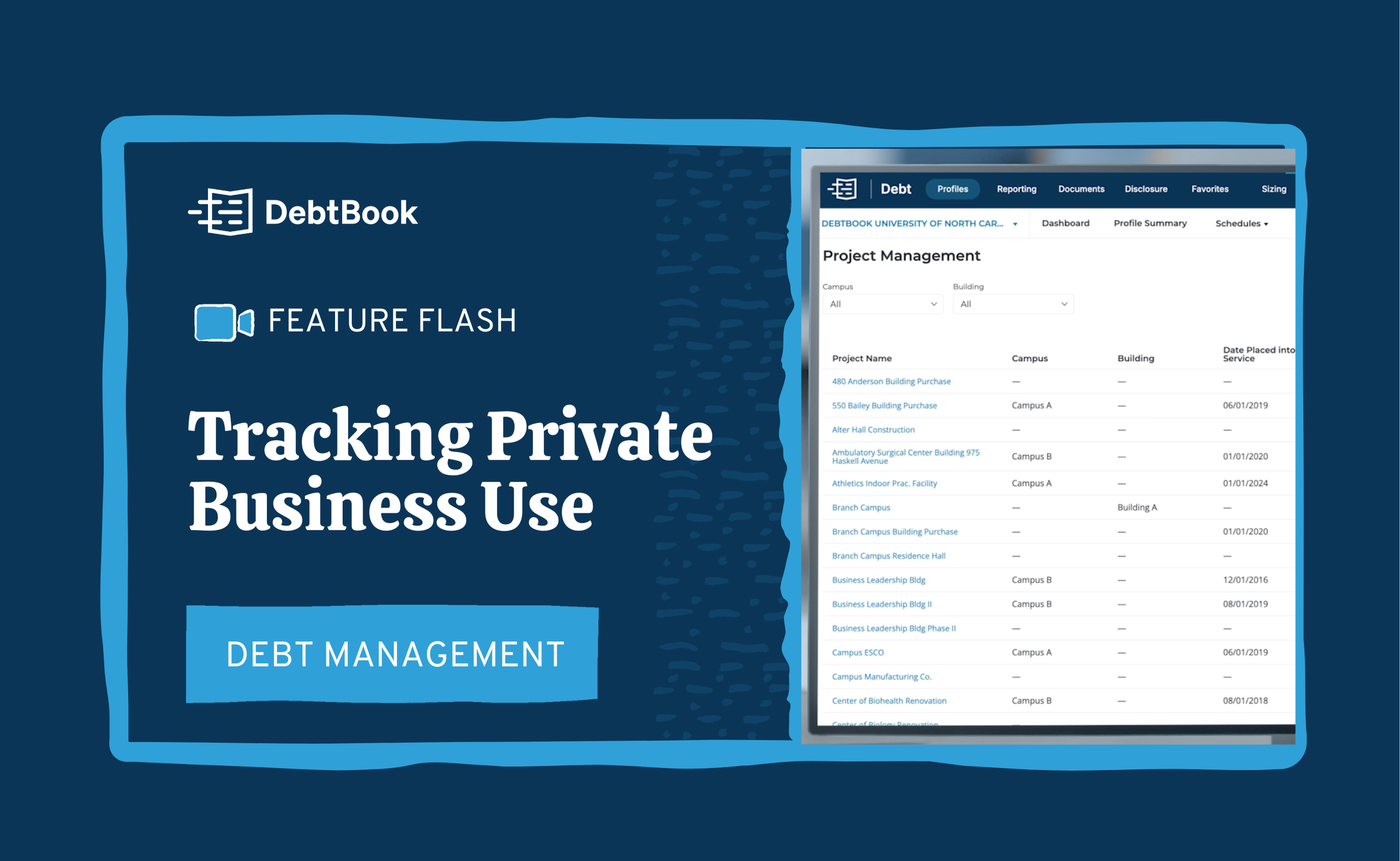Whenever a municipal entity decides to finance a capital project, they need a cost-efficient method to ensure effective funding. If the municipal entity were to receive a grant from the federal government or donations from philanthropists, the cost of the project would be reduced, possibly to no cost at all. If the municipal entity has excess cash on hand, likely in their revenue fund, or short-term investments that are maturing soon, they could reduce future interest expense and the overall cost of the project.
But the reality is, deciding to use cash, investments, or financing is a balancing act of interest expense and potential interest revenue (reinvestment).
Most municipal entities don’t have extra cash on hand or don’t want to exit investments early. Additionally, while federal grants or donation contributions from philanthropists can lower the cost of the project, the entity will likely still need to finance a portion of the project.
Understanding Project Costs and the Importance of Drawdown Schedules
The first step in financing a project is to understand the costs of the project. The primary expense is the construction costs. An engineering firm designs the project, usually creating a drawdown schedule. The drawdown schedule shows the issuer how much money they should anticipate spending in the future on the dates specified and should be used to create a “what-if'' scenario of an entity’s cash forecast. This schedule would be monthly, bi-monthly, or quarterly.
It’s important to note that the drawdown schedule is only an estimate, and the municipality should expect potential changes to the schedule in the future, unless they enter a design-build contract, which locks in the cost. [1]
When including a drawdown schedule into “what-if” scenarios within a cash forecast, an entity can see the potential impact this financing could have on its cash balances. This helps determine whether it’s worth pursuing the project or if it can be funded using existing cash balances and upcoming investment maturities.
Below is a sample of what a potential drawdown schedule would look like for a $100,000,000 project expected to be completed in two years:

Methods to Finance a New Capital Project
There are various ways to finance a new capital project, each having its risks and rewards. The following covers several of these methods:
Finance the Project Using Tax-Exempt Bond Financing
The first key concept to remember is that the drawdown schedule for a new money project financing is an estimate on how many dollars will be needed at each future drawdown date. Due to potential construction delays or weather-related issues, the drawdown schedule could change after the bonds are sold. This could mean the issuer may need to secure additional funds from another source, such as another bond transaction or a small bank loan, to complete the project.
Projects financed “for the good of the people” and meet all the federal tax rules can be financed with tax-exempt proceeds. Tax-exempt issues have the benefit of usually being cheaper (i.e., issued at a lower interest rate) than taxable issuances.
When projects are financed "for the good of the people," it means they are intended to serve public interests and provide community benefits rather than generate profit for private entities.
These projects often focus on improving public infrastructure, such as roads, schools, hospitals, and parks, enhancing the quality of life for residents.
The main fundamental restriction associated with tax-exempt proceeds is that the issuer cannot make any positive arbitrage (i.e. The issuer cannot reinvest the bond proceeds in securities that earn above the rate of the bonds being issued).[2] The amount of arbitrage is calculated when the project is completed, although it can be calculated periodically throughout the life of the construction period.
The yield on the cash flow of the actual securities purchased during the construction period is calculated and compared to the arbitrage yield of the tax-exempt bonds. If the yield on these securities exceeds the arbitrage yield on the bonds, positive arbitrage occurs, and the issuer must rebate the difference back to the IRS.
Not all bond issues are subject to this reinvest earnings constraint (i.e., the requirement to rebate the over earnings), as there are exceptions to the rule. [See Appendix A]
From a basic mathematical perspective, the average life of a construction account in our example is approximately one-year. This allows the issuer to invest in taxable securities with a similar one-year average life. In contrast, the average life of the tax-exempt bond issue might be around 15 years, resulting in a borrowing rate equivalent to a 15-year tax-exempt rate. This rate is usually higher than the one-year taxable rate (unless the yield curve is steeply inverted) so there is an overall additional cost of the construction fund equal to the lost earnings not achievable between the two rates during the life of the construction fund.
Methods of Financing a Construction Account with Bond Proceeds
The issuer has two methods of financing a construction account (e.g., $100 million of total cost over three years) with bond proceeds:
- Gross funding the construction account: Tax-exempt bond proceeds fund the construction account for the full value of the total requirement (e.g., $100 million). If the proceeds are invested, the interest earnings can be used to finance other tax-exempt needs. In this funding method, as long as the interest earnings are not needed to fund any part of the project, the interest risk, although prevalent, will not affect the project’s successful financing.
- Net funding the construction account: Tax-exempt bond proceeds fund the construction account assuming the bond proceeds will be invested in permissible investments and the earnings will be used to finance the project.[3] This means that when deciding how much money is needed to deposit into the construction account, future earnings on investment are considered so the initial deposit can be reduced (e.g. $98.5 million with $1.5 million coming from reinvestment earnings), reducing the required amount of bonds to be sold.
As an example of a net funded drawdown schedule, if we assume the average return on the invested proceeds is 1.85%, we could present value the drawdown schedule requirements at a rate of 1.850% (semi-annual compounding) to find out how much bond proceeds the issuer actual needs to meet the future drawdowns.

In our example, the issuer would need to initially deposit $98.5 million into the construction account and earn 1.85% on the money throughout the life of the construction account to meet the drawdown’s scheduled $100 million of requirements. If the issuer was unable to achieve the 1.85% return on the investments, the issuer would have to get additional money from a different source in the future to complete the project. In this type of financing methodology, it’s smart to use a very conservative reinvestment rate.
In reality, the issuer would give the trustee of the construction account the $98.5 million in cash and instruct the trustee to invest the cash in permissible investment securities. The cash flow from those securities would meet the drawdown schedule as per the engineer’s schedule.
Below is a sample of a construction account funded with hypothetical treasury securities:

The main challenge with net funding a construction account is managing any changes in the construction requirement dates or amount. In those situations, the trustee may have to either sell securities in the fund earlier than expected or reinvest matured securities until the money is needed. This can result in potential gains or losses from the sale of the securities, as well as potential changes to the future cash flow.
Most construction requirements set by engineers do change over time, so the construction fund must be closely monitored. Each purchase or sale of securities could create idle cash if not managed efficiently. Also note that gains or losses from selling the securities will be factored into the final return rate calculation.
Finance the project using taxable bond financing
Taxable bond proceeds are used when the project is targeted to benefit a non-tax-exempt entity (e.g., a hospital wing that will only have offices for doctors’ practices). Depending on the spread between taxable and tax-exempt bond yields, taxable bond financing will usually cost more in interest expense than tax-exempt bond financings.
On the positive side, because the bonds are taxable and the buyer does not get any tax benefits, there are no restrictions on how the issuer either spends the money or reinvests the money.
Finance the project using tax-exempt commercial paper
Using a tax-exempt commercial paper (TECP) program reduces most of the risk associated with incorrect calculations by engineers or project delays that push financing needs to later dates.
The first step in using TECP is defining the TECP program which includes setting up the maximum amount outstanding at any one time. Once the program is established, the issuer can “draw” (i.e., sell to the public) the amount of money they need to meet a project’s funding requirement. TECP can be sold in maturity lengths between 1 – 270 days (note: TECP is a short-term financing vehicle). The issuer continues to draw on the TECP program whenever they have a need to finance a construction draw. If some TECP matures, the issuer can resell the TECP back into the market.
Due to the continuous maturation of TECP, the issuer must have the funds on hand to repurchase the TECP from the current holder and then resell it to another buyer. The issuer must either have strong credit and sufficient cash on hand to repurchase maturing TECP or purchase a letter of credit from a bank to ensure funds are available to repay TECP holders, thereby mitigating roll-over risk.
Most TECP issuances for capital needs are part of a financing plan to “take-out” (i.e., refinance) the TECP with fixed rate bonds in the future when interest rates are low.
Since TECP is considered a short-term financing vehicle, it carries interest rate risk. If interest rates increase when it’s time to either sell new commercial paper to meet new construction requirements or to resell maturing commercial paper, the issuer may face higher costs. This risk is compounded by the fact that long-term rates might never be as low as the fixed rates available had the issuer sold fixed-rate bonds initially.
Finance the project using tax-exempt variable rate demand obligations
When issuing variable rate demand obligations (VRDOs), the issuer locks in the future maturity dates but does not lock in the interest rates. The rates are reset periodically, usually based on a public municipal index (e.g., SIFMA Municipal Market Swap Index). This means the issuer is exposed to interest rate risk unlike fixed-rate debt but unlike a TECP program, the issuer has all the money for the construction requirements upfront.
Like TECP, the issuer must either have a strong credit rating or purchase a letter of credit from a bank. This ensures that funds are available in case holders of VRDOs return them to the issuer due to unfavorable reset rates, thereby mitigating roll-over risk. At that point the issuer must have cash on hand to repay the existing variable rate holder until they resell the VRDOs back into the market.
Most VRDOs issuances for capital needs are part of a financing plan to “take-out” (i.e., refinance) the VRDOs with fixed-rate bonds in the future when interest rates are low.
Below is the diagram displaying the mechanics required for a VRDO program due to the potential of roll-overs.

[Source: Municipal Securities Rule-making Board (MSRB)]
Conclusion
In order to finance a project with tax-exempt proceeds, the project must be created “for the good of the people” and not for any specific party. In those cases, a municipality can issue taxable securities to finance the project. All the same issues with tax-exempt proceeds apply, except that the municipality can invest the construction fund proceeds at a rate higher than their borrowing rate, if possible.
The bottom line, determining how best to balance the use of cash and financing requires significant administrative work and cross-functional collaboration. Entities are expected to be good stewards of their monies, which includes reducing interest expenses and maximizing interest revenues while preserving principal. They must also ensure that sufficient funding is available to meet obligations in a timely manner, so projects are completed on time and within budget.
Appendix A– Exceptions to the arbitrage rebate rules
Not all tax-exempt bond issuances have to meet the arbitrage yield restriction on bond proceeds reinvestments–there are exceptions to the rule. If the issuer meets any of the spending exceptions below, they will not have to rebate any earnings above the arbitrage yield back to the IRS.
When calculating these exceptions, the amount spent after each period is based on the actual expenditures and not the anticipated drawdown schedule as designed by the engineer.
One note – when calculating the percentage of bond proceeds needed to be spent when applying an exception, you must include both the construction account and the capitalized interest account investments, if applicable, when calculating the percentages.
In calculating the percentages, the time period is based on the number of days from the delivery of the bonds to the bondholders.
- Exception 1 – 100% of the proceeds are spent within the six months of the delivery date
- Exception 2 – 100% of the proceeds are spent within 18 months, as follows
a. 6 months: 15%
b. 12 months: 60%
c. 18 months: 100% - Exception 3 – 100% of the proceeds are spent within 24 months, as follows
a. 6 months: 10%
b. 12 months: 45%
c. 18 months: 75%
d. 24 months: 100%
Example: The below expenditure of TSY securities meets the 24 month spend down rule and thus the securities could have earned above the arbitrage and the issuer would not have had to rebate any of the earnings back to the IRS.

Sources:
1 Design-Build is a method to deliver a project in which the design and construction services are contracted by a single entity known as the design–builder or design–build contractor. Design–build places the responsibility for design errors and omissions on the design–builder, relieving the owner of major legal and managerial responsibilities. The burden for these costs and associated risks are transferred to the design–build team. Design–build also has a single point responsibility. The design-build contractor is responsible for all work on the project, so the client can seek legal remedies for any fault from one party. [Wikipedia]
2 Positive arbitrage is when the overall return on the securities in the construction account (or any yield restricted account funded with bond proceeds) earns above the “arbitrage yield”. For tax purposes, the arbitrage yield is the overall bond yield of the bond issuance, as defined by the IRS.
3 Investments permitted under the bond resolution (e.g., treasury securities, certain agency securities)
Related Municipal Finance Reading
- What the Refunding is Going On? Exploring Tax-Exempt Bond Refunding
- Bond Insurance: Making a Marketable Credit Better
- Credit Rating Trends: The Key to Knowing Your Issuer
Disclaimer: DebtBook does not provide professional services or advice. DebtBook has prepared these materials for general informational and educational purposes, which means we have not tailored the information to your specific circumstances. Please consult your professional advisors before taking action based on any information in these materials. Any use of this information is solely at your own risk











